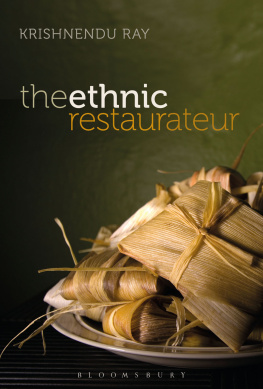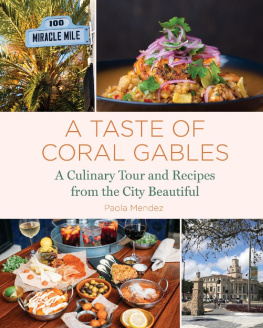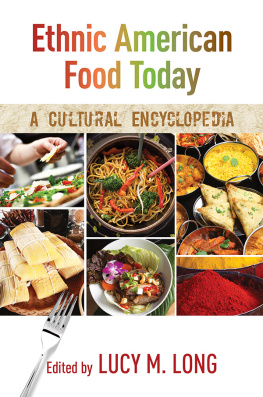To Maa and my Pishis

Contents
The foreign-born as a percentage in selected occupations, USA and New York City, 1860
The foreign-born as a percentage in selected occupations, USA and New York City, 1900
The foreign-born as a percentage in selected occupations, USA and New York City, 1950
The foreign-born as a percentage in selected occupations, USA and New York City, 2000
The mystery of kachori
A portion of Vada Paos menu
The rise of the restaurant and the decline of the saloon: ratio of coverage in The New York Times (NYT) (18512013)
The rise of the restaurant and the decline of the saloon: ratio of coverage in the Los Angeles Times (LAT) (18802013)
The rise of the restaurant and the decline of the saloon: ratio of coverage in the Chicago Tribune (18501999)
The rise of the restaurant and the decline of the saloon: ratio of coverage in the New York Tribune/Herald (18411962)
Percentage of documents with the words caf, saloon, tavern, and restaurant combined in the New York Tribune/Herald, NYT, Chicago Tribune, and LAT (ca. 18512013)
Twin peaks of public discussion of restaurants in the US
Comparative popularity of cuisines over time, NYT 18812013
Popularity of major Zagat-rated cuisines in NYC (19862014)
Rank by price, Zagat NYC (19862014)
Michelin, Zagat, Menupages coverage of NYC restaurants in 2014
Comparative popularity of ethno-nationally-marked Zagat-rated restaurants in four selected US cities in 2010
Hierarchy of taste: check averages of NYC Zagat-rated restaurants in 2010
Zagat survey: New York City restaurants at the decadal benchmark
Menu theme as percentage of all restaurants in the National Restaurant Association sample (19842010)
Zagat: Americas Top Restaurants
I have benefited immensely from criticism and encouragement over the years from a number of sources: first and foremost my doctoral students Sierra Burnett Clark and Jackie Rohel, who also conducted some of the best interviews on which this book is based; Anne McBride, with whom I contested many of the enclosed arguments; Hiilei Hobart and Christy Spackman, who steered me in various productive theoretical directions; graduate students in the Food Studies Doctoral Seminar at CUNYin a course taught by Barbara Katz-Rothman and Jon Deutschwhere I first presented the idea in any coherent form; numerous Masters students on whom I tried out some of my arguments; my colleagues Amy Bentley and Jennifer Berg; audiences at annual meetings of the American Sociological Association and the Association for the Study of Food and Society, where I presented early versions of the chapters; and my confederates in The BAWG, Julie Elman, Toral G. Gajarawala, Maggie Gray, Thuy Linh Tu, and Jessamyn Hatcher. Of course, I have often ignored their very good advice and have said what I needed to say in my own way. Feedback from two anonymous reviewers, twice, over a two-year period, was central to re-working the manuscript for coherence and clarity. Vanina Leschziners insistence that I make clearer the distinction between popularity and prestige of various cuisines forced me to wrestle down in a more competent way. Jose Johnston and Shyon Baumanns Foodies was essential to my articulation of the difference between their story and mine. Paul Freedman has been a remarkable senior colleague who has encouraged me and provided numerous opportunities to think big which have forced me out of the narrow ethnic corner of the field. Thanks to Jo, Piya, and Dan Bender for giving me the space and time, and providing me with the material and emotional frame of mind in Toronto to finish the writing. Most importantly I owe an immense debt of gratitude to the many named and unnamed immigrant restaurateurs who took time off from their very busy schedules to talk to us through the duration of the project.
I had never cooked a meal when I came to the United States in 1988 as a young adult. I had made omelets, taught by a Boy Scouts Camp Counselor in Jamshedpur. I had brewed tea a handful of times. Thats it. That kind of experience with cooking is not an exception. A recent OECD study, released in March 2014, shows Indian men coming pretty close to last in global terms of sharing domestic care-giving work (Rana 2014). In my case, cooking is what mothers, aunts, grandmothers, and servants did. Even if I appreciated the eternal recurrence of delectables, I did not think much about the everyday improvisation of cooking and cleaning. Now I cook often, write about food, and teach it. That was a transformation wrought not by a conscious, thinking, and virtuous subject but by the force of circumstances and the absence of servants and women. My turn to food studies was catalyzed by the realizationforced by immigrationnot only that I did not know how to cook, but that I had never thought about it. It was that lack of consciousness about everyday skills of sustenance, in spite of the apparently progressive Marxist politics that I had adopted in high school and college, that cried out for attention. In some ways, progressive, public politics covered over my domestic ineptitude. More than twenty years of cooking, cleaning, and material and affective care-giving was left unaccounted for either in the economic calculations or the narrative of my self. That debt seems to have lingered somewhere, to bubble and burst into recompense in a whole new life. Perhaps we can call it a hauntology, after a famous philosopher (Derrida 2006).
I did not think my way out of that ineptitude. Instead, the process should be described as first finding my way through doing what needed to be done, and then the slow, fragmentary, recuperation of that process in thought. I cooked because I had to cook. I thought about it because I had developed an unavoidable habit of doing so. Furthermore, my hands had to be forced to surrender the license of living without a care. I was obviously not the first man to realize that fact, but migration was central to that epistemological recognition, which would shape my subsequent trajectory. Yet it was also retrospective distance rather than proximity that produced insight. In this preface I tell you why I turned to cooking, to the surprise of my family and friends. What that did to my thinking? And how might that in turn contribute to the fields of food studies, sociology, and immigration studies?
My turn to cooking came in graduate school, amidst the heavy theorizing and philosophical engagement that is typical at that age and in such institutions. For a long time I could not reconcile the mundane doing and the high thinking. How could I connect a series of mere household events, the common, the low, and the familiar (Das, Jackson, Kleinman, and Singh 2014), with the philosophical strategy of distancing myself from everyday experience? What could be the relationship between the sovereign subject of philosophy and the fragile subject of everyday life, with his craving for the ordinary pleasures of good taste? That is the ground between preparing and eating food, and studying it, as I have come to see after the thoughtful work of Veena Das and her colleagues. For Das it was unclear what could ever be of philosophical interest in the trivial details of the insecurities of everyday life (2014: 279). In Michael Jacksons apposite but unintended response, philosophy saves us from drowning by providing us with the means of regaining our sense of comprehension, composure, and command in a world of confusing and confounding experience (Das
Next page




